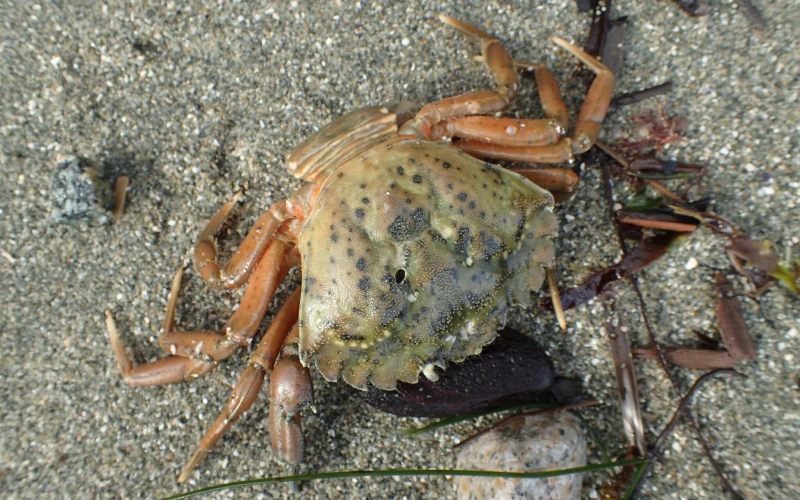European Green Crab
Description
The European Green Crab is a small, highly adaptable, and aggressive marine crustacean. It is identifiable by its serrated, pentagon-shaped shell, distinct spines near the eyes, and different-sized front claws. It can grow up to ten centimeters and exhibits colors ranging from green to red or yellow. Its territorial and aggressive nature makes it a formidable predator and competitor within marine ecosystems.

European Green Crab © Ian Cruickshank, some rights reserved (CC BY-NC)
Identifying Features
Distribution and Invasiveness
Native to Europe and North Africa, European Green Crab has spread widely across Canada’s coastlines. Its introduction to North America is attributed to ballast water from ships and ocean currents. Distinct populations have established themselves in both Atlantic (late 1950s) and Pacific regions (1990s), showing variations in cold tolerance and adaptability.
Habitat
European Green Crabs thrive in shallow waters, including salt marshes, eelgrass beds, rocky shores, and sandy beaches. They can tolerate a wide range of temperatures and salinity, contributing to their invasiveness [1]. The adult crabs are particularly hardy, able to survive out of water for over five days, utilizing hiding spots such as crates, boats, buckets, and various types of gear. Make sure to inspect any fishing gear for signs of European Green Crab.
Impacts
Response and Management
Management efforts focus on preventing their spread through early detection, containment, and control measures. Partnerships between government agencies, academia, and community groups aim to educate and train on identification and control strategies. Despite challenges in eradication, efforts like the Clean, Drain, Dry initiative for watercraft and equipment aim to minimize the spread and impact of European Green Crabs.
What You Can Do:
Report it: If you think you have found an aquatic invasive species report it to Fisheries and Oceans Canada. Never return it back to the water.
Additional Information
For more details on the European Green Crab, including management strategies and how to report sightings, visit: https://www.dfo-mpo.gc.ca/videos/green-vert-eng.html
Resources
Management efforts focus on preventing their spread through early detection, containment, and control measures. Partnerships between government agencies, academia, and community groups aim to educate and train on identification and control strategies. Despite challenges in eradication, efforts like the Clean, Drain, Dry initiative for watercraft and equipment aim to minimize the spread and impact of European Green Crabs.
1. Gehrels, H., Knysh, K.M., Boudreau, M. et al. Hide and seek: habitat-mediated interactions between European green crabs and native mud crabs in Atlantic Canada. Mar Biol 163, 152 (2016). https://doi.org/10.1007/s00227-016-2927-6
2. Matheson, Kyle & Mckenzie, Cynthia & RS, Gregory & Robichaud, David & Bradbury, Ian & Snelgrove, Paul & GA, Rose. (2016). Linking eelgrass decline and impacts on associated fish communities to European green crab Carcinus maenas invasion. Marine Ecology Progress Series. 548. 31-45. 10.3354/meps11674.